2023 Triumph Tiger 1200 Review - First Ride

This cat's claws are sharper than ever
Triumph’s open-class ADV bike, the Tiger 1200 (or Tiger Explorer depending on what era we’re talking about), had begun to get a little long in the tooth. The big cat hadn’t received a major overhaul since its introduction in 2012 – only receiving incremental upgrades to keep the machine relevant over the past 10 years. The Brits did give the bike some refreshes and new tech over that time, but nothing compared to the latest iteration that I was lucky enough to get a proper two-day test of around the backroads and trails of the Iberian Peninsula.
2023 Triumph Tiger 1200
Editor Score: 89.5%
| Engine | 18.5/20 | Suspension | 14/15 | Transmission | 9/10 |
| Brakes | 9.5/10 | Instruments | 3.5/5 | Ergonomics | 8.5/10 |
| Appearance | 9/10 | Desirability | 9/10 | Value | 8.5/10 |
+ Highs
- Excellent adaptable suspension
- Ride modes that make a difference
- Weight loss
– Sighs
- Engine mapping could use refinement
- TFT lags
- No more electronic windscreen… sigh
2018 Triumph Tiger 1200 XCa Review
All-new! We hear all too often. Fortunately, however, when asked what components had been carried over from the previous Tiger 1200 family to these new models, Chief Engineer Stuart Wood replied with a smile, “I believe there are a few fasteners.” The 2023 Triumph Tiger 1200 is truly a ground up redesign. Before we dig into the bits and bobs, as they say, let’s take a look at what we have in the Tiger 1200 lineup.
All in the family
Five models make up the Tiger 1200 line for 2023. We have the GT subset which includes the standard GT, GT Pro, and GT Explorer. These models make up the more road-focused variants in a line which offers loads of touring comfort and tarmac performance, while still being game for the odd adventure. The Rally Pro and Rally Explorer models are better equipped for off-road expeditions with longer travel suspension and a 21-inch front wheel, among other things.
Cast wheels in a 19/18-inch combo are standard fare on the GT models, allowing them to steer more quickly thanks to their smaller size and weight compared to the larger spoked wheels of the Rally models. Metzeler Tourance tires are standard issue.
Showa semi-active suspension is used across the model range with the GT line offering up 7.9 inches of travel with 10% stiffer springs. Two-position seats are also equipped to all trim levels, with the GT’s ranging in height from 33.5 inches to 34.3 inches. The street-focused models are also a bit shorter in length and have a less steep rake and more trail than the off-road models.
Standout features of the Explorer models include a 7.9-gallon tank, engine protection bars, heated seats for the rider and passenger, and blind spot detection from its rear-facing radar.
Rally models set themselves apart with 0.8-inches of extra suspension travel, giving them 8.7 in. of total travel at both ends. Additionally, the Off-road Pro ride mode is included, allowing users to disable traction control and ABS entirely. Metzeler Karoo Street tires are wrapped around tubeless spoked wheels in a proper 21/18-inch off-road combo. Seat heights range from 34.4 to 35.2 inches on the Rally models.
One of Triumph’s major engineering feats with the new 1200 range has been a substantial reduction in weight. The GT model comes in at a claimed 529 lbs with the largest model, the Rally Explorer tipping the scales at 575 elbees. Pricing for the GT models ranges from $19,100 to $23,100 while the Rally Pro and Rally Explorer retail for $22,500 and $24,200, respectively.
Tiger 1200 overview
As Mr. Wood alluded in his statement about fasteners, the 2023 Tiger 1200 range has been entirely revamped from the ground up. In this monumental task, Triumph’s goals were a reduction in weight, an increase in power, and improved rideability with more purposeful and focused performance for the task at hand.
Hinckley says the new package is more than 55 pounds lighter than before which, with our last top-o-the-line Tiger 1200 tipping the MO scales at 632 lbs, 575 for the ’23 Rally Explorer seems about right. Weight reduction comes from every nook and cranny of the Tiger 1200 with the frame, engine, and shaft drive being just a few areas showing considerable weight loss.
The new, smaller 1160 cc Triple now uses the T-plane crank setup we first saw on the Tiger 900 range. The T-plane crank has a 1, 3, 2 firing order – a configuration Triumph uses to help coax Twin-like performance out of the Triple at low rpm while still delivering excellent power through the mid- to upper-rpm range that Hinckley’s Triples are known for. In addition, it makes for a pretty great soundtrack.
Triumph claims the new Triple makes 148 horsepower at 9,000 rpm and 96 lb-ft of torque at 7,000 rpm at the crank. The last Tiger 1200 we ran on the dyno during our 2018 Big Bore Adventure Touring Shootout made 114.6 hp at 8,600 rpm and 67 lb-ft of torque at 7,000 at the rear wheel.
The Tiger 1200 retains shaft drive but now uses a single shaft versus the two-peice configuration from previous years. The new setup uses a “tri-link” setup forgoing the single-sided swingarm from previous years. Although it looks complex, we’re told tire changes only require one extra bolt to be removed compared to any other traditional double-sided swingarm. Triumph says the tri-link configuration saves more than three pounds of unsprung weight – not an insignificant amount. Recommended maintenance for the final drive is an oil refresh every two years regardless of mileage. That’s the kind of final drive maintenance schedule we can all get behind.
Speaking of maintenance, Triumph has also increased the new Triple’s service intervals to 10,000 miles for oil changes and 20,000 miles for valve checks.
We’re told the entire chassis, frame, and engine have been rotated forward in its design to place the bike’s center of gravity closer to the front contact patch, giving better front end feel to the rider.
The Showa semi-active suspension features many of the tricks we’ve come to expect from electronic suspension, including optimum damping settings for each ride mode; these are constantly adjusting at a rate of 50 milliseconds during the ride. There’s also the ability to adjust damping characteristics manually over nine levels, and automatic preload setting based on how the bike is loaded.
The suspension is also able to detect jumps and increase damping for landings. Showa also uses what it calls a “virtual spring rate” which, in theory, controls the spring rate by adjusting damping forces when the suspension is at higher stroke positions. This gives a progressive feel to the shock that is typically achieved through a linkage system.
Across the Tiger 1200 range, Brembo Stylema calipers clamp two 320mm discs at the front, with a single-piston Brembo unit clenching a 282mm disc out back. Continental’s IMU-based cornering ABS is also standard fare across the five trims. Braking is linked in all but off-road modes and uses specific ABS parameters that are based on ride modes.
On-road
I actually started my day of testing on the tarmac with the Rally Explorer. After half a day’s ride on that machine, the difference between it and the GT Pro that I hopped on after lunch was night and day. Really, it shouldn’t be surprising that the 21-inch front wheel and extra heft on the Explorer models was easily felt while railing through corners. Circling back to my comment about the new Tiger 1200 range feeling more focused, there is a massive difference in feel between the GT and Rally models, and it mainly boils down to the smaller, lighter cast wheels.
Yes, you can feel the extra weight on the Explorer models and the larger front wheel on the Rallys, but it doesn’t take long to get used to and didn’t stop me from keeping up with the pack as we blasted through the Portuguese countryside.
The biggest feature that stood out after some time on the asphalt was just how well the suspension adapts to the road surface. Although I did tweak the damping characteristics in ride modes to get a feel for the differences, I never felt it was necessary. The baseline settings and semi-active suspension adjustment worked fantastically. Also, despite the amount of braking force generated by Brembo’s stellar Stylemas, the anti-dive damping works almost as well as the telelever setup found on other bikes (cough*BMW*cough). The Showa units are highly refined and complex and manage to work better than I thought was even possible. Big round of applause to Showa and Triumph. I am very impressed.
Naturally, the engine is the next standout feature. The 1160cc Triple lost some of its sewing machine smoothness in favor of a bit more bark and rawness. This did translate into a bit more vibes being carried through the machine, but not enough to bother me during our ride. That said, we were never droning down the highway for much time, but if we were, at least we have cruise control. In Sport mode, on/off throttle input can be a bit jerky, and really, it can be somewhat annoying when scooting through small towns at low speeds. However, slotting the Tiger into Road mode really seemed to smooth out the on/off throttle lurchiness.
Once we had made our way out of town, I left the bike in Road mode for a bit which delivered a smooth, controlled ride from the suspension with an equally smooth delivery of power. Clicking the big cat back into Sport mode (via the aptly named joystick) for the twisty bits thoroughly changed the character of the bike. The stiffer suspension kept everything very well composed and the bike never felt like it was moving through the stroke too fast. Even in fast switchbacks, damping felt controlled and deliberate. Throttle response was much sharper with Sport mode, allowing the engine to rev up much quicker into its meaty mid-range as it smoothly climbed toward the bike’s 9,500 rpm redline.
I really appreciated the difference between the ride modes. In the past, I’ve ridden motorcycles that, when switched between ride modes, don’t feel drastically different – with the Tiger 1200, you feel like you’ve just swapped motorcycles.
On the road, the GT Pro and its 5.2-gallon tank feel like the quickest of the bunch, as they should. Triumph has managed to make that bike feel small and manageable – compared to the other models – for an open-class ADV machine. With its smaller cast wheels, it’s easy to hustle through the tightest of corners with confidence that you can easily adjust mid-corner if necessary. That said, once I had some time on the GT Explorer, I found the front end even more planted and confidence inspiring. Yes, you can feel the weight of the extra fuel the Explorer carries (approximately 16.2 pounds worth) and it is all up high – there is no low slung tank like that of the KTM adventure bikes, but even still, it didn’t put a damper on our ride.
If I were looking for a road-biased British adventure bike, the Tiger 1200 GT Explorer would be the ticket. I like the extra fuel range, could take or leave the rear facing radar for blind spot detection – which does work quite well, whether with bikes or cars – and all the fantastic electronics that come with it.
Triumph’s ability to keep some of the character of the previous Tiger 1200, yet make it better in nearly every way, is a testament to the brand’s engineering prowess. Also, the fact that the machine feels so much different between modes – and with the amount of adjustment – really lets the rider decide how they like their dish served.
On the street, the Tiger 1200 is an absolute hoot to ride, thanks to its chassis composure and the engine’s excellent mid-range, which, when combined with strong brakes and ride modes that actually change the character of the machine, peg the limiter. The Tiger 1200 is causing some deja vu for me from our Middleweight Adventure comparison where the Tiger 900 Rally Pro showed up as an excellent all-around adventure machine, not focused too pointedly in any direction, but delivering well-rounded performance from every angle.
Off-road on the Rally Pro
Being able to handle business on the road isn’t enough though in the adventure-verse. It needs to be competent off-road as well. To be honest, I was worried after our street ride. I had switched between Road and Sport ride modes primarily and felt the motor, despite its new T-plane crank, was a bit soft on the bottom end. I assumed that during any slow going off-road I was going to be slipping the clutch quite a bit to keep the bike from stalling. We would see.
While the Tiger 1200 doesn’t hold a candle to the low-speed performance of the BMW GS, switching the bike into its Off-road modes again changes the character of the motorcycle more than I expected. The engine is still not as punchy at low-rpm as a big Twin, but there’s enough punch down there to have fun.
For our time off-road, Triumph had rotated the handlebar forward, removed the passenger footpegs from the bolt-on subframe, and equipped factory-spec Metzeler Karoo 3s. Otherwise, we were working with the stock settings.
In Off-road mode, rear ABS is disabled and the front is dialed back to allow more slip before intervening. Off-road traction control is used to allow a safety net should your wrist be too heavy for your ambitions. Suspension can be adjusted separately in any ride mode, but again, at a medium pace, the stock default of 5/9 on the suspension scale seemed reasonable for those looking to have fun while traveling versus us speed-addicted journos hellbent on destruction.
After switching into Off-road Pro, ABS and traction control are a thing of the past, allowing for all the hooliganism you’re willing to get yourself into – and with 1160cc of Triple goodness between your legs, it’s hard to be mature. Damping settings are dialed up to 8/9 toward Sport, and as it was on the street, the Showa components do an excellent job of keeping the ride composed. I did manage to bottom the shock while riding at a hot pace, but even then, the bike didn’t spring back up wildly, the semi-active suspension keeps the action smooth in nearly every situation.
The biggest takeaway from the off-road ride, which consisted of mostly fire roads, but included single-track, two-track, a few loose climbs, and even some bits of sloppy mud was, again, the bike’s composure. The Tiger 1200 Rally Pro did a great job of staying in line whether I was breaking the rear end loose to slide around corners or hopping off little jumps on two-track trails. Feel from the front tire was excellent and immensely confidence inspiring on a bike of this size. To have some fun while still keeping it together for a full “adventure tour” – whatever that may mean to you – the Tigre 1200 should be an apt dance partner.
In the end
“Is the all-new Tiger 1200 better in every way,” I thought to myself? I think so. It’s lighter, more powerful, and handles much better overall than the outgoing models. Like the Tiger 900 Rally Pro which, in my opinion, is probably the best all-around middleweight adventure bike, the new 1200s seem to be following suit.
Maybe the Tiger 1200 is not the sportiest on-road, and perhaps it’s not the most hardcore off-road, but it does do both very well and it does so with all of the electronic adjustability and safety nets we’ve come to expect on these pricey adventure machines. Really though, there’s only one way to know for sure how the new Tiger compares to the stacked open-class adventure segment. I’d say it’s time to get the band back together.
In Gear
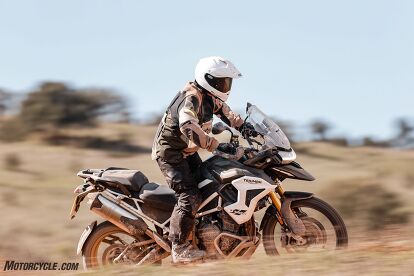
Helmet: Shoei Hornet X2
Communicator: Cardo Packtalk Black
Jacket: Alpinestars Halo Drystar
Gloves: Alpinestars Chrome
Pants: Alpinestars Venture XT
Boots: Alpinestars Tech 7
2023 Triumph Tiger 1200 Specifications | |||||
|---|---|---|---|---|---|
GT | GT Pro | GT Explorer | Rally Pro | Rally Explorer | |
| MSRP | $19,100 | $21,400 | $23,100 | $22,500 | $24,200 |
| Engine Type | Liquid-cooled, 12 valve, DOHC, inline 3-cylinder | ||||
| Displacement | 1160 cc | ||||
| Bore x Stroke | 90.0 mm x 60.7 mm | ||||
| Compression | 13.2:1 | ||||
| Horsepower | 148 hp at 9,000 rpm (claimed) | ||||
| Torque | 96 lb-ft. at 7,000 rpm (claimed) | ||||
| Fuel System | Multipoint sequential electronic fuel injection with electronic throttle control | ||||
| Exhaust | Stainless steel 3 into 1 header system with underslung primary silencer and side mounted secondary silencer | ||||
| Final Drive | Shaft drive | ||||
| Clutch | Hydraulic, wet, multi-plate, slip & assist | ||||
| Transmission | 6 speed | ||||
| Frame | Tubular steel frame, with forged aluminum outriggers. Fabricated, bolt-on aluminum rear subframe. | ||||
| Swingarm | Twin sided “Tri-Link” aluminum swingarm with twin aluminum torque arms. | ||||
| Front Wheel | Cast aluminum, 19 x 3.0in | Spoked (tubeless), 21 x 2.15in. | |||
| Rear Wheel | Cast aluminum, 18 x 4.25in | Spoked (tubeless), 18 x 4.25in. | |||
| Front Tire | Metzeler Tourance 120/70R19 (M/C 60V TL) | Metzeler Karoo Street 90/90-21 (M/C 54V TL) | |||
| Rear Tire | Metzeler Tourance 150/70R18 (M/C 70V TL) | Metzeler Karoo Street 150/70R18 (M/C 70V TL) | |||
| Front Suspension | Showa 49mm USD forks with semi-active damping; 7.9 inches of travel. | Showa 49mm USD forks with semi-active damping; 8.7 inches of travel. | |||
| Rear Suspension | Showa monoshock with semi-active damping and automatic electronic preload adjustment; 7.9 inches of travel. | Showa monoshock with semi-active damping and automatic electronic preload adjustment; 8.7 inches of travel. | |||
| Front Brakes | Brembo M4.30 Stylema monoblock radial calipers, OC-ABS, twin 320mm floating discs. Magura HC1 span adjustable radial master cylinder with separate reservoir. | ||||
| Rear Brakes | Brembo single piston caliper, OC-ABS, single 282mm disc. Rear master cylinder with remote reservoir. | ||||
| Instruments | Full-colour 7” TFT instrument pack with My Triumph Connectivity System | ||||
| Length | 88.4 inches | 88.4 inches | 88.8 inches | 89.4 inches | 90.4 inches |
| Width | 33.4 inches (handlebars), 38.7 inches (handguards) | ||||
| Height Without Mirrors | 56.5 – 58.9 inches (adjustable screen) | 58.5 – 60.9 inches (adjustable screen) | |||
| Seat Height | 33.5 – 34.3 inches (adjustable) | 34.4 – 35.2 inches (adjustable) | |||
| Wheelbase | 61.4 inches | ||||
| Rake | 24.1° | 23.7° | |||
| Trail | 4.7 inches | 4.4 inches | |||
| Wet Weight (Claimed) | 529 pounds | 540 pounds | 562 pounds | 549 pounds | 575 pounds |
| Fuel Tank Capacity | 5.3 gallons | 5.3 gallons | 7.9 gallons | 5.3 gallons | 7.9 gallons |
We are committed to finding, researching, and recommending the best products. We earn commissions from purchases you make using the retail links in our product reviews. Learn more about how this works.
Become a Motorcycle.com insider. Get the latest motorcycle news first by subscribing to our newsletter here.

Ryan’s time in the motorcycle industry has revolved around sales and marketing prior to landing a gig at Motorcycle.com. An avid motorcyclist, interested in all shapes, sizes, and colors of motorized two-wheeled vehicles, Ryan brings a young, passionate enthusiasm to the digital pages of MO.
More by Ryan Adams



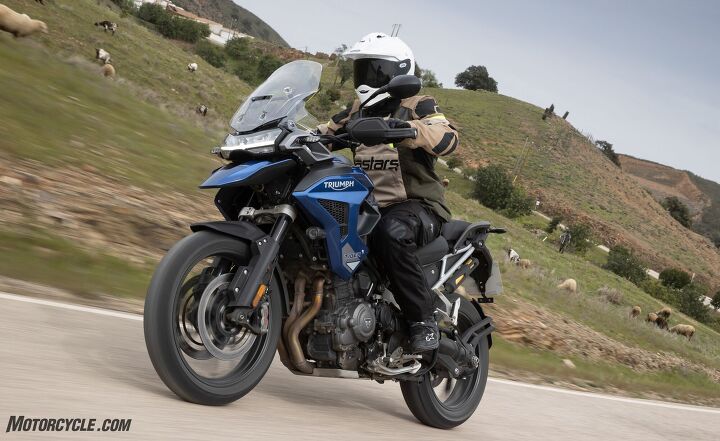
































































































































































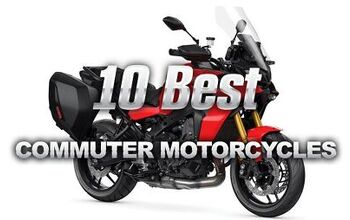


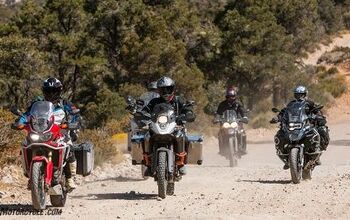
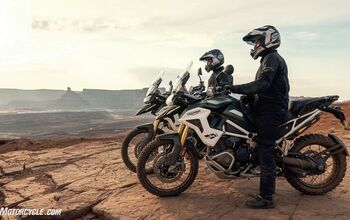











Comments
Join the conversation
Triumph made a great all around bike... the Pan Am was a great beginning from a non ADV company and rightfully earned it's praise, but it couldn't beat the GS as the Queen of ADV bikes... but will the Triumph beat it or come so close that it doesn't matter on which one you are sitting... we will see... well whether it will or not... It made my heart pitter patter...
Great job Ryan. I have greatly enjoyed seeing your writing and analysis sharpen these past several years. You must be working hard at your craft. Congratulations.